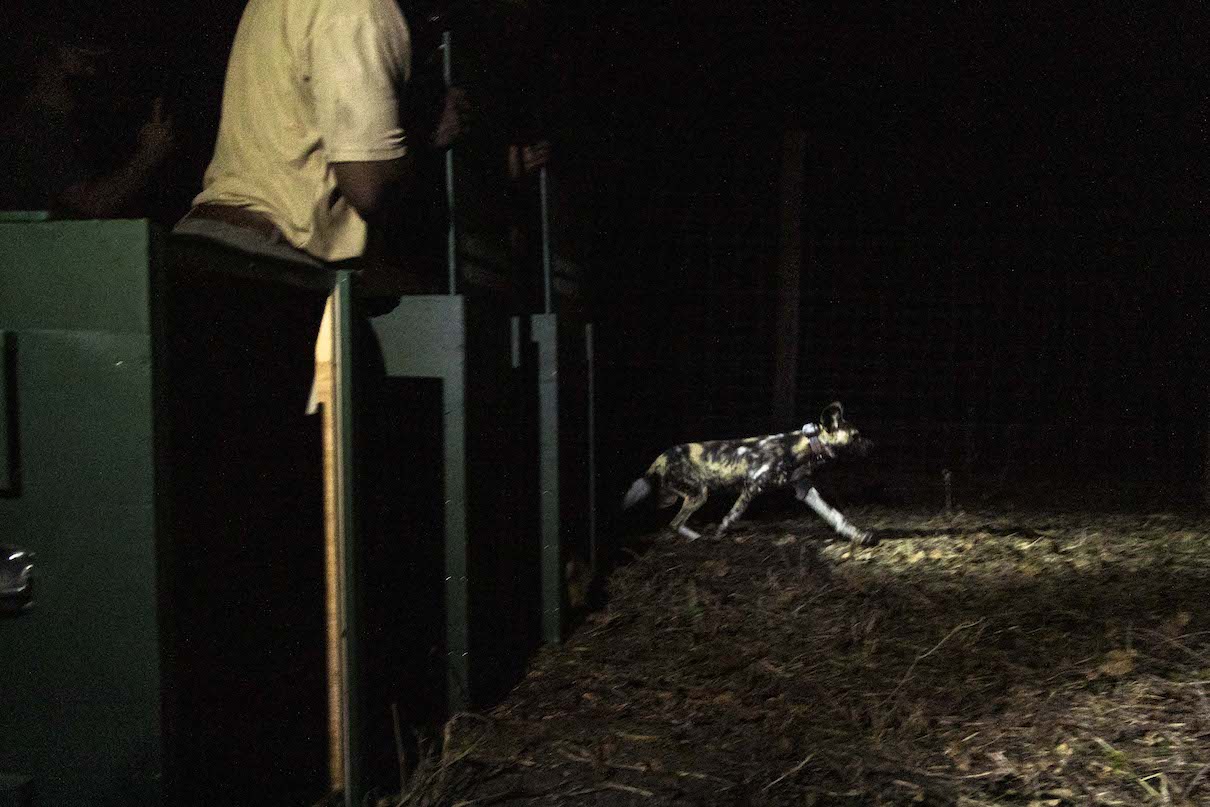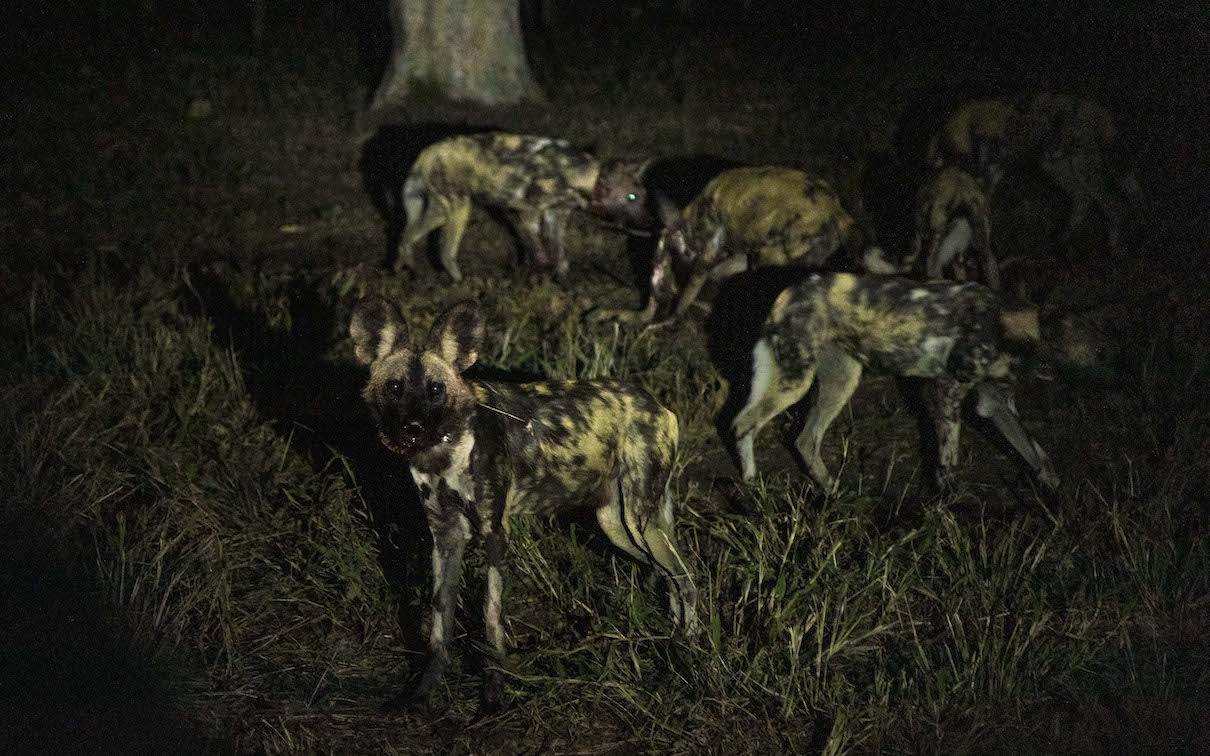- Fourteen endangered African wild dogs were recently translocated to Malawi in an attempt to reestablish populations in Liwonde National Park and Majete Wildlife Reserve.
- There are currently only about 6,600 African wild dogs, including 700 breeding pairs, left on the African continent.
- Experts say the success of the translocation will hinge upon whether the dogs reproduce and form a larger population, and also if they manage to stay away from danger if they wander outside the reserve.
Beams of light cut through darkness as people stand by a row of transport crates, preparing to open them. When they pull up the side panels, three dogs with mottled coats and white-tipped tails slip out into the darkness. A fourth stays in his crate, resting his head on the floor, but he gazes ahead with wide, alert eyes.

These animals are just a few of the 14 African wild dogs (Lycaon pictus), also known as painted wolves, recently released in Liwonde National Park and Majete Wildlife Reserve in southern Malawi, where the endangered species hasn’t been seen in about 20 years. In the western part of Malawi, however, experts say there may be a small population.
In Malawi, as in other parts of Africa, these wild canines have fallen victim to zoonotic diseases, bushmeat hunting, as well as deliberate shootings and poisoning by livestock farmers. The animals are also commonly run over by vehicles as residential and commercial developments take over their habitat. There’s also new research showing that African wild dogs are struggling to cope with the rising heat due to human-induced climate change.

It’s estimated there are only about 6,600 African wild dogs, including 700 breeding pairs, left on the entire African continent.
“The African Wild Dog is one of the most endangered mammals on the continent, facing significant threats almost across its remaining range,” Angela Gaylard, head of science support for African Parks, a South Africa-based conservation NGO, told Mongabay in an email. “To see this extremely vulnerable species re-established in Malawi as a result of our international collaboration is therefore a profoundly moving, hopeful development for conservation.”
The reintroduction of these African wild dogs was a team effort between African Parks and another South African conservation group, Endangered Wildlife Trust (EWT). African Parks helps manage the Liwonde and Majete protected areas in collaboration with Malawi’s Department of National Parks and Wildlife (DNPW). The whole process took “months of hard work,” said Derek van der Merwe from EWT. This was also the third attempt to get the dogs to Malawi, after earlier plans had to be postponed due to COVID-19 disruptions and even local road closures in South Africa following the arrest of former president Jacob Zuma.
“It was a relief to get all 14 dogs safely to Malawi,” Van der Merwe told Mongabay in an email.

The dogs, which originated from Mozambique and South Africa, were eventually flown in a small aircraft from Mozambique to Malawi on July 27. Then they were released into specially designed bomas in Liwonde National Park and Majete Wildlife Reserve, where they will stay until they’re used to their surroundings.
“The wild dogs seem to be settling in well,” Van der Merwe said. “They will be held in a holding boma to acclimatize until they are fully released. Both alpha females are pregnant so the wild dogs will most likely be released before the pups are born.”
The packs will be fitted with radio and satellite collars so rangers can keep a close eye on them. Gaylard said the success of the translocation will hinge upon whether the dogs successfully reproduce and grow in population in the reserves.
The reintroduction of the 14 African wild dogs is part of a larger project to rewild Malawi. Over the past 18 years, African Parks has worked with the Malawian government to translocate thousands of animals representing a range of threatened species, including elephants, giraffes and black rhinos, into Majete, Liwonde, and Nkhotakota Wildlife Reserve.

Claudio Sillero, professor of conservation biology at Oxford University and chair of the IUCN Canid Specialist Group, said he was pleased to see the release of the 14 dogs, but added that the success of the reintroduction will depend on whether the dogs find suitable habitat and prey, and manage to stay out of trouble if they leave the reserves. African wild dogs are known to travel 40 to 50 kilometers (25 to 30 miles) a day, he said.
“Conservation translocations offer potential for wild dog recovery in some areas where they have disappeared, provided that livestock farmers are engaged throughout the planning, and any ensuing conflict is promptly mitigated,” Sillero told Mongabay in an email.
Gaylard said she’s optimistic that the reintroduction will succeed, thanks to the commitment of countries like Malawi, Mozambique and South Africa to reverse the trend of biodiversity loss.
“Hopeful stories like this one from Malawi demonstrate how it is possible, with visionary government leadership and with sufficient support, to conserve vital landscapes, helping to fundamentally change the trajectory not just of a single endangered species but of entire ecosystems,” she said. “This is crucial for the creation of opportunities for sustainable socio-economic development, enabling the long-term prosperity of both people and wildlife.”
Citation:
Rabaiotti, D., Groom, R., McNutt, J. W., Watermeyer, J., O’Neill, H. M. K., & Woodroffe, R. (2021). High temperatures and human pressures interact to influence mortality in an African carnivore. Ecology and Evolution, 11(13), 8495-8506. doi:10.1002/ece3.7601
Banner image caption: African wild dogs safely released into a purpose-built boma prior to their release into Majete Wildlife Reserve Malawi. Image by Matt Moon.
Elizabeth Claire Alberts is a staff writer for Mongabay. Follow her on Twitter @ECAlberts.
FEEDBACK: Use this form to send a message to the author of this post. If you want to post a public comment, you can do that at the bottom of the page.
